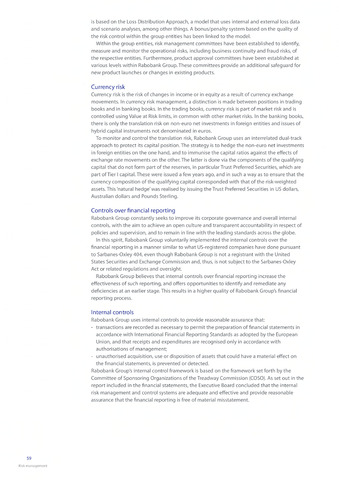is based on the Loss Distribution Approach, a model that uses internal and external loss data
and scenario analyses, among other things. A bonus/penalty system based on the quality of
the risk control within the group entities has been linked to the model.
Within the group entities, risk management committees have been established to identify,
measure and monitor the operational risks, including business continuity and fraud risks, of
the respective entities. Furthermore, product approval committees have been established at
various levels within Rabobank Group.These committees provide an additional safeguard for
new product launches or changes in existing products.
Currency risk
Currency risk is the risk of changes in income or in equity as a result of currency exchange
movements. In currency risk management, a distinction is made between positions in trading
books and in banking books. In the trading books, currency risk is part of market risk and is
controlled using Value at Risk limits, in common with other market risks. In the banking books,
there is only the translation risk on non-euro net investments in foreign entities and issues of
hybrid capital instruments not denominated in euros.
To monitor and control the translation risk, Rabobank Group uses an interrelated dual-track
approach to protect its capital position. The strategy is to hedge the non-euro net investments
in foreign entities on the one hand, and to immunise the capital ratios against the effects of
exchange rate movements on the other. The latter is done via the components of the qualifying
capital that do not form part of the reserves, in particular Trust Preferred Securities, which are
part of Tier I capital. These were issued a few years ago, and in such a way as to ensure that the
currency composition of the qualifying capital corresponded with that of the risk-weighted
assets. This'natural hedge'was realised by issuing the Trust Preferred Securities in US dollars,
Australian dollars and Pounds Sterling.
Controls over financial reporting
Rabobank Group constantly seeks to improve its corporate governance and overall internal
controls, with the aim to achieve an open culture and transparent accountability in respect of
policies and supervision, and to remain in line with the leading standards across the globe.
In this spirit, Rabobank Group voluntarily implemented the internal controls over the
financial reporting in a manner similar to what US-registered companies have done pursuant
to Sarbanes-Oxley 404, even though Rabobank Group is not a registrant with the United
States Securities and Exchange Commission and, thus, is not subject to the Sarbanes-Oxley
Act or related regulations and oversight.
Rabobank Group believes that internal controls over financial reporting increase the
effectiveness of such reporting, and offers opportunities to identify and remediate any
deficiencies at an earlier stage. This results in a higher quality of Rabobank Group's financial
reporting process.
Internal controls
Rabobank Group uses internal controls to provide reasonable assurance that:
- transactions are recorded as necessary to permit the preparation of financial statements in
accordance with International Financial Reporting Standards as adopted by the European
Union, and that receipts and expenditures are recognised only in accordance with
authorisations of management;
- unauthorised acquisition, use or disposition of assets that could have a material effect on
the financial statements, is prevented or detected.
Rabobank Group's internal control framework is based on the framework set forth by the
Committee of Sponsoring Organizations of the Treadway Commission (COSO). As set out in the
report included in the financial statements, the Executive Board concluded that the internal
risk management and control systems are adequate and effective and provide reasonable
assurance that the financial reporting is free of material misstatement.
59
Risk management

